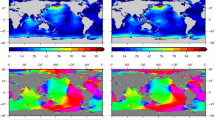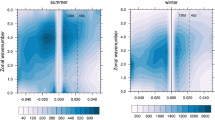Abstract
Numerical celestial-mechanical models are used to compare (andg interpolate and forecast) near-diurnal tidal variations in the Earth’s axial rotation and oscillations in the global angular momentum of the atmosphere using the IERS data and NCEP/NCAR meteorological data. In order to improve the accuracy of interpolations and forecasts made for short and intraday time intervals, it is expedient to include the effect of small perturbations in short-term zonal tides, which influence fluctuations in Universal Time UT1 directly related to the Earth’s rotation. Due to the quasi-static formulation of the problem, it is assumed that the dynamics of the thin surface atmosphere are completely determined by the gradient of the tide-generating geopotential, which supports forced oscillations of the entire subsystem (i.e., of the mantle and atmospheric envelope). A comparison of the numerical simulations with the NCEP/NCAR data shows that the model is effective for applications in forecasting atmospheric tides.
Similar content being viewed by others
References
IERS Annual Report 2000, Ed. by W. Dick and B. Richter, International Earth Rotation and Reference Systems Service, Central Bureau (BKG, Frankfurt am Mein, 2001).
IERS Annual Report 2002, Ed. by W. Dick and B. Richter, International Earth Rotation and Reference Systems Service, Central Bureau (BKG, Frankfurt am Mein, 2003).
International VLBI Survice for Geodesy and Astrometry: Observing Programs, http://ivs.nict.go.jp/mirror/program/.
The NCEP/NCAR Reanalysis Project at the NOAA/ESRL Physical Sciences Division, http://www.esrl.noaa.gov/psd/data/reanalysis/reanalysis.shtml.
C. Audoin and B. Guinot, The Measurement of Time: Time, Frequency and the Atomic Clock (Cambridge Univ., Cambridge, 2001; Tekhnosfera, Moscow, 2002).
L. D. Akulenko, S. A. Kumakshev, Yu. G. Markov, and L. V. Rykhlova, Astron. Zh. 82, 950 (2005) [Astron. Rep. 48, 847 (2004)].
L. D. Akulenko, Yu. G. Markov, V. V. Perepelkin, and L. V. Rykhlova, Astron. Zh. 85, 1 (2008) [Astron. Rep. 52, 590 (2008)].
L. D. Akulenko, Yu. G. Markov, V. V. Perepelkin, and L. V. Rykhlova, Astron. Zh. 87, 3 (2010) [Astron. Rep. 53, 260 (2009)].
L. D. Akulenko, Yu. G. Markov, and V. V. Perepelkin, Dokl. Akad. Nauk 432, 1 (2010) [Dokl. Phys. 55, 217 (2010)].
Author information
Authors and Affiliations
Additional information
Original Russian Text © L.D. Akulenko, Yu.G. Markov, V.V. Perepelkin, L.V. Rykhlova, 2011, published in Astronomicheskii Zhurnal, 2011, Vol. 88, No. 9, pp. 920–928.
Rights and permissions
About this article
Cite this article
Akulenko, L.D., Markov, Y.G., Perepelkin, V.V. et al. Fluctuations in the angular momentum of the atmosphere and intraday irregularities in the Earth’s rotation. Astron. Rep. 55, 849–856 (2011). https://doi.org/10.1134/S1063772911080014
Received:
Accepted:
Published:
Issue Date:
DOI: https://doi.org/10.1134/S1063772911080014




